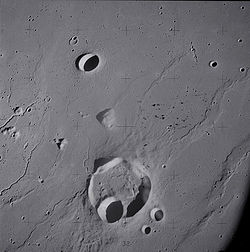 Apollo 15 image | |
| Coordinates | 29°01′N45°37′W / 29.02°N 45.61°W |
|---|---|
| Diameter | 22.87 km (14.21 mi) |
| Depth | 1.1 km |
| Colongitude | 46° at sunrise |
| Eponym | Johann N. Krieger |


Krieger is a lunar impact crater on the eastern part of the Oceanus Procellarum. It is located to the north-northwest of the flooded crater Prinz, and north-northeast of the prominent ray crater Aristarchus. To the northwest lies the small Wollaston. The crater was formally named in 1935. [1]
Contents
In the past the floor of Krieger has been flooded by basaltic lava, leaving only a low, circular, somewhat polygonal ridge formed by the rim. The southern rim is broken across by the small Van Biesbroeck, and there is a small gap in the western rim. A meandering rille leads away from this break toward the northwest.